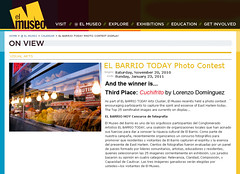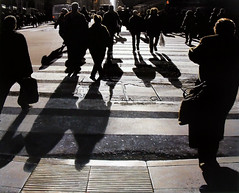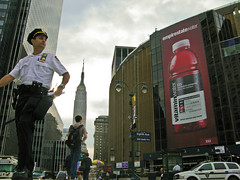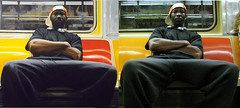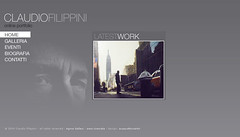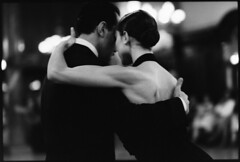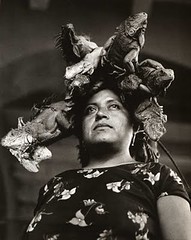 A Conversation with Graciela Iturbide and Martín Weber
A Conversation with Graciela Iturbide and Martín Weber
Originally uploaded by lorenzodomPhoto: 1979 Nuestra Señora de las Iguanas Juchitán, México, © Graciela Iturbide
A Conversation with 2011 Lucie Award Winner Graciela Iturbide and Martín Weber
by Lorenzo Domínguez
(Originally published by En Foco, October 27, 2010)
On Sunday, October 24th, Graciela Iturbide and Martín Weber spoke before an attentive audience at the annual Nueva Luz Artist Talk co-sponsored by En Foco and Lucie Foundation, as part of the week long festivities leading up to the Lucie Awards.
Graciela Iturbide
Many of her fans had come out to listen to this iconic photographer speak about her work, both present and past. Included amongst her admirers was Amber Terranova, photo editor at Photo District News (PDN) who enthusiastically relayed, “(Graciela) is one of my favorite photographers. Her images resonate with me because of the way she captures the spirit of a place and a culture. Also, she’s visually provocative and quite prolific.” To show the extent of her admiration she had brought along two of Iturbide’s books with her, hoping Ms. Iturbide would sign them.
Born in 1942 in Mexico, Graciela was the oldest of 13 children. She turned to photography to grapple with the death of her six-year-old daughter in 1960 and under the mentorship of teacher, cinematographer and photographer Manuel Álvarez Bravo, she eventually learned the craft that would bring her much acclaim as an artist.
Dismissing the notion that she must keep up with the times, Iturbide only photographs with film, most of her work is in black and white, and she is best known for her focus on the marvels of everyday life. In addition to more than 60 exhibitions of her work around the world, she has also been the recipient of prestigious awards including the Eugene Smith Grant in Humanistic Photography in 1987, a John Simon Guggenheim Memorial Fellowship in 1988, the Hasselblad Award in 2008, and on Wednesday she will receive an award for Achievement in Fine Arts from Lucie Foundation.
Her photos of everyday life often showcase fascinating images such as her photo Mujer Ángel (Angel Woman) featuring a rural peasant climbing a mountainside with a boombox in her hand, or perhaps her best known picture— Nuestra Señora de Las Iguanas (Our Lady of the Iguanas)—which shows a woman with bushel of hair made entirely of a dozen dead iguanas to be sold as meat in the market.*
To her dismay, the significance of this particular photograph is wholly usurped by the bizarre image itself, for the photo was part of an important series about the Zapotec women of Juchitán, Oaxaca, a city where women dominate village life, as well as rule over the marketplace. Moreover, taken during several trips to the area between 1979 and 1988, this series established her stature as a strong supporter of feminism.
Nonetheless, it is this photo that helped Iturbide make her mark, to the point where the locals in Juchitán adopted it as their own, many of them putting up posters of the photo in their homes and eventually renaming the image “The Juchitán Medusa.” In 2008, the stature of this photo prompted the Smithsonian Magazine to publish a story about it and how it became so well-known—Day of the Iguanas.
Iturbide explains, “The camera is an excuse to share the life of the people, the rhythm and simplicity of festivities, to discover my country. While using my camera I am, above all, an actress participating in the scene taking place at the moment, and the other actors know what role I play. I never think of my images as a project, I simply live the situations and photograph them; it is afterwards that I discover the images.”
Martín Weber
Despite Graciela’s stature as an artist, it was her co-presenter, Martín Weber, and his work, A Map of Latin American Dreams, that truly stole the show for the evening.
Made over a period of 15 years, his series of black-and-white photographs show primarily impoverished people from countries throughout Latin America including Argentina, Brazil, Colombia, Cuba, Guatemala, Mexico, Nicaragua, and Peru, with an individual—sometimes alone, sometimes in the middle of a group—holding a small black chalkboard upon which he or she has written a dream.
Martin explains, “Sharing their stories, these dreamers restore our awareness of individual and collective experience. In a globalized world, dreams are often reduced to commodity status. Countries and continents are frequently exploited as mere sources of trade. The histories of our communities can be made visible…Our destiny will change when we allow ourselves to imagine differently from what we were given.”
Some of the more moving dreams and photographs include:
- Mi hermano sueña con estudiar música (My brother dreams of studying music)
- Mi sueño es morirme (My dream is to die)
- Ser abogada (To be a lawyer)
Every one of the subjects is markedly somber; almost none reveal a smile, apart from a naïve child here and there. One almost immediately gets the impression that folks throughout Latin American are depressed. That said, Weber’s pictures do have a purpose. His photos, tell how unemployment in Latin America is driving the middle class into poverty, and that the disparity between the rich and the poor is continually expanding, creating a pattern of cycles that abet further social fragmentation, political violence and economic instability.
The Talk
The talk began with an introduction of Elizabeth Ferrer, a curator and writer who is also an authority on Mexican and Latin American photography, by Miriam Romais, Executive Director of En Foco.
Elizabeth began by introducing Martín who read and translated the wishes conveyed by each individual in his photographs.
Since it was suggested that questions from the audience be deferred to the end, Martín deferred any further comments about his work to allow the headliner to take the stage.
Instead of simply showing her photographs though, Graciela began by speaking about how and why she started taking photographs. Through an interpreter she conveyed to the audience that she felt photography allowed her to know her country, Mexico, in a way that she would not otherwise. She also mentioned that she loved taking photos of objects throughout the world and that “in all landscapes and objects, one can feel a human presence.”
She also mentioned that her most recent work is focusing on “el mundo fantasia,” the world of fantasy as inspired by her nietos. To do so, she had to retreat to her archives to find images that would appeal to the imaginations of her grandchildren.
Since Graciela seemingly preferred to discuss her work, rather than merely show it, the audience was allowed to ask her questions before the official Q&A had begun for both speakers.
Asked what prompted her to go to India to take photographs, Iturbide immediately and repeatedly gave Mary Ellen Mark, who was in the audience, credit for her inspiration to travel there. “Mary Ellen said ‘I had to go.’”
When asked what is the significance of birds in her imagery, she answered with a sincere smile, “I don’t know,” arousing a bit of laughter from everyone. She went on to explain, “I never know why I take photos. I suppose it is simply intuition. For example, in my photo Ojos para volar (Eyes to Fly With), I have one live bird and one dead bird over my eyes. It was simply something that I intuitively and spontaneously decided to do. I suppose that I simply have an obsession with the flight of birds.”
Cat Jimenez, Executive Director of the Lucie Foundation, asked Graciela about her Asor series, to which she went on to describe a little about each photo shown—a floating body during a Mexican ritual, a construction site which she referred to as “iron gardens,” and a carnival in the distance over an arid landscape somewhere in Texas. Ultimately, she said that, once again, it was about “intuition” and it was difficult to explain.
Graciela went on to speak about her photo series of Frida Kahlo’s bathroom, which she was invited to photograph 15 years after it had been closed by Frida’s husband, the muralist and painter Diego Rivera. She elaborated, “We had discovered that it had been closed for fifty years, not fifteen, as Diego had claimed. Ultimately, I ended up taking photos of objects that revealed Frida Kahlo’s pain”—a prosthetic leg, a poster of Stalin, crutches, back braces, and corsets.
She ended her talk by declaring, “I don’t want to be the photographer known only for her ‘The Lady of Iguanas’ photo anymore. In fact, they are now making a sculpture of that iconic picture. I think it will be horrible.”
Audience Q&A
The official Q&A from the audience began with a question for both photographers:
What is your dream?
Graciela answered, “Quiero Soñar,” I want to dream.
And Martín, almost sadly, said, “To be with my family.”
Weber was then asked, “In group photos how did you choose the individual?”
He immediately responded, almost shyly, “Mostly it was my intuition.”
Also posed to Weber, “How do you approach your subjects, to garner their honesty?”
Martín answered, “My work is based on trust; there is something very powerful with photography. I sought to create spaces where they were willing to share something. Surprisingly to me, 99% of them said ‘Yes.’”
Asked to Iturbide, “What is most similar between Mexican and Indian culture?”
“Their rituals about death. The yellow flowers, the marigolds, that they both place over the dead.” After further thought, she further added, “Actually, they are not similar. They are different cultures,” and deferred further explanation to Mary Ellen Mark, who has also worked in both places.
Both photographers were asked “What kind of richness would you like your work to reveal to viewers, especially to those ‘outside’ of Latin American culture?”
Iturbide responded, “I think that the fact that we were all colonized by either the Spanish or the Portuguese gives us a common history. We all have beautiful pueblos (communities). Yet, so many have to migrate to the United States, because the one thing a lot of us do not have are—jobs. This is why we suffer so much adversity, there is no work in Latin America. I’ve worked with immigrants before and it vexes my soul.”
“Moreover, despite this problem and others like drug trafficking, the people, our villages, are marvelous. This is why I like to photograph the dignity of these pueblos.”
The talk officially ended when Cat Jimenez asked the final question of Graciela, “Why don’t you use digital photography?”
“I don’t like it,” she candidly answered, explaining, “As per the title of a short film I did with Alejandro Gómez de Tuddo, Hay tiempo, hay tiempo (There is time, there is time). I want to have time to take and develop my photos. Film allows, and even forces, you to take time with your work.”
Graciela Iturbide will be presented with the Achievement in Fine Art award at the Eighth Annual Lucie Awards to be held on Wednesday, October 25 at Lincoln Center in New York.
An exhibit of Martín Weber’s work, along with that of photographer Joseph Rodriguez, titled Cultural Memory Matters, is now showing at 601Artspace in Chelsea. The show runs through March 12, 2011.
* This image is featured in a poster for En Foco’s 1991 Intercambio program, in Puerto Rico. Graciela’s work was also featured in En Foco’s 1988 exhibition, Latina.
For More Information
www.webermartin.com
Martín Weber on En Foco
Print Collectors Program: Martín Weber
Graciela Iturbide on En Foco
www.601artspace.org
www.rosegallery.net
lucieawards.com
www.enfoco.org
*
Check out the #1 Best Selling Photo Essay and Artist & Photography Biography
on Amazon.com 25 Lessons I’ve Learned about Photography Life!
Vote for Lorenzo in the One Life International Photography Competition!
Connect with Lorenzo on Facebook!
